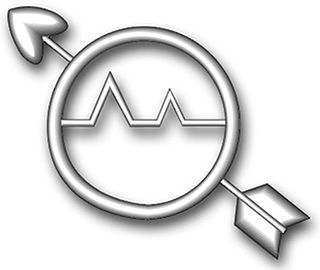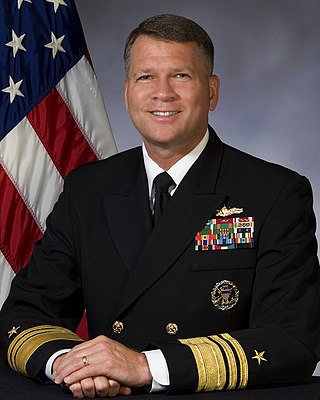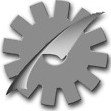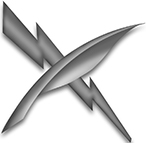
The Central Security Service (CSS) is a combat support agency of the United States Department of Defense which was established in 1972 to integrate the National Security Agency (NSA) and the Service Cryptologic Components (SCC) of the United States Armed Forces in the field of signals intelligence, cryptology, and information assurance at the tactical level. In 2002, the CSS had approximately 25,000 uniformed members. It is part of the United States Intelligence Community.
The Enlisted Aviation Warfare Specialist (EAWS) insignia is a military badge of the United States Navy which was created in March 1980. The insignia recognizes those members of the Navy's enlisted force who have acquired the specific professional skills, knowledge, and military experience that result in qualification for service in the aviation activities of the Navy. This includes most personnel who are trained flight deck personnel onboard aircraft carriers, or maintenance personnel at an Aircraft Intermediate Maintenance Detachment or Department (AIMD) or aircraft squadron.

The United States Navy's Center for Information Warfare Training (CIWT) is one of the learning centers of Naval Education and Training Command, headquartered on Naval Air Station Pensacola Corry Station in Escambia County, Florida. It is responsible for the development of education and training policies for over 26,000 members of the Information Warfare Corps in the fields of cryptology and intelligence, along with the cyber realms of information operations and technology, and computer systems and networks. The center also oversees Language, Regional Expertise and Culture.
The Air Force Specialty Code (AFSC) is an alphanumeric code used by the United States Air Force to identify a specific job. Officer AFSCs consist of four characters and enlisted AFSCs consist of five characters. A letter prefix or suffix may be used with an AFSC when more specific identification of position requirements and individual qualifications is necessary. The AFSC is similar to the Military Occupational Specialty Codes used by the United States Army and the United States Marine Corps or enlisted ratings and USN officer designators and Naval Officer Billet Classifications (NOBCs) used by the United States Navy and enlisted ratings and USCG officer specialties used by the United States Coast Guard. The United States Space Force equivalent is known as the Space Force Specialty Code (SFSC).

The AN/SLQ-32 is a shipboard electronic warfare suite built by the Raytheon Company of Goleta, California and The Hughes Aircraft Company. It is currently the primary electronic warfare system in use by U.S. Navy ships. Its operators commonly refer to it as the "Slick-32".

Technical research ships were used by the United States Navy during the 1960s to gather intelligence by monitoring, recording and analyzing wireless electronic communications of nations in various parts of the world. At the time these ships were active, the mission of the ships was covert and discussion of the true mission was prohibited. The mission of the ships was publicly given as conducting research into atmospheric and communications phenomena. However, the true mission was more or less an open secret and the ships were commonly referred to as "spy ships".

Radioman (RM) was a rating for United States Navy and United States Coast Guard enlisted personnel, specializing in communications technology.

Aviation electronics technician (AT) is a US Navy enlisted rating or job specialty. At the paygrade of E-9, ATs merge with the aviation electrician's mate (AE) rating to become avionics technicians (AV). There has been talk of completely merging the two ratings, but as yet no definite plans have been announced. Aviation electronics technicians wear the specialty mark of a winged helium atom.

Operations Specialist is a United States Navy and United States Coast Guard occupational rating. It is a sea duty-intensive rating in the Navy while most of Coast Guard OS's are at ashore Command Centers.

David John "Jack" Dorsett is a corporate vice president for cyber and C4 at Northrop Grumman, and a retired vice admiral of the U.S. Navy. He was the first Deputy Chief of Naval Operations for Information Dominance and 63rd Director of Naval Intelligence. He served as the Director of Intelligence, Joint Chiefs of Staff from 2005 to 2008 prior to assuming his position on the Chief of Naval Operations staff.

Information systems technician (IT) is a rating for United States Navy and United States Coast Guard enlisted personnel, specializing in communications technology. Information systems technician submarines (ITS) is a rating for U.S. Navy submariners. The Information systems technician (IT) rating corresponds to the new Navy Occupational Specialty (NOS) code B460 while the information systems technician submarines (ITS) rating corresponds to Navy Occupational Specialty (NOS) code C260.

The United States Navy job rating of electronics technician (ET) is a designation given by the Bureau of Naval Personnel (BUPERS) to enlisted members who satisfactorily complete initial Electronics Technician "A" school training.
The U.S. Navy Information Warfare Community (IWC) leads and manages a cadre of officers, enlisted, and civilian professionals who possess extensive skills in information-intensive fields. This corps works in information, intelligence, counterintelligence, human-derived information, networks, space, and oceanographic disciplines to support US Navy, Joint and national war fighting requirements. The IWC is part of a U.S. Navy initiative to merge intelligence with command, control, communications, and computers.

The United States Navy occupational rating of data processing technician was a designation given by the Bureau of Naval Personnel (BUPERS) to enlisted members who satisfactorily completed initial data processing technician "A" school training.










